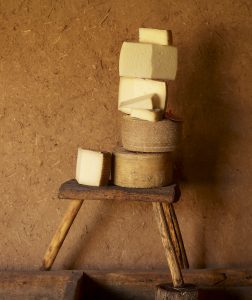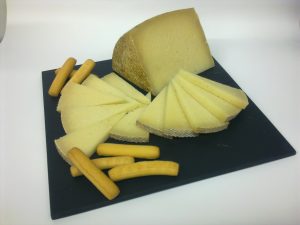THE AROMA OF RAW MILK CHEESES MARKS QUALITY
Artisan cheese, made from raw milk, whether from cows, sheep or goats, is one of the main protagonists of the gastronomic revolution that has been taking place in Spain in recent years.
It is an appreciated product, because the personality of a cheese, in addition to the milk, is given by the landscape in which it was produced. It is a food that speaks, perhaps more than any other, of remote regions and ancestral ways of life. For this reason, artisan raw milk cheeses linked to the territory are more appreciated.
Raw milk offers more intense flavors, more butteriness and personality and also a little more acidity, a touch of salt and some spiciness. Although experts say that all cheeses are good, even those produced industrially, pasteurized milk does not offer such strong flavors, milk and rennet are some of the differences between an artisan cheese and an industrial one. A large production plant that uses pasteurized milk from various sources is not the same as an artisan cheese factory that uses milk from cattle grazing in a specific territory and whose feed reflects the landscape of the area. For this reason it is said that artisan cheeses are living beings that help preserve the landscape.

Raw milk offers more intense flavors
Pasteurization of milk in industrial cheeses is a real practical necessity, because when milk from very different origins is brought together, it is essential to eliminate pathogenic bacteria. But, on the other hand, pasteurization kills useful bacteria in the milk and inactivates many of the enzymes in the milk itself, thus eliminating two of the four or five sources of flavor during ripening and preventing traditional cheeses from having that flavor that makes them unique.
The Spain of cheeses
Cheese in Spain is cows, sheep, goats and also shepherds, and there are plenty to choose from. Since 1969, different censuses of Spanish cheeses have been carried out to collect the artisan cheeses distributed throughout the country. This census is constantly increasing. There are currently more than 100 different varieties of cheese, listed in the “Spanish Cheese Catalog” and 26 Denominations of Origin. It may not seem much when compared to France, the world’s leading cheese producer with some 360 different types of cheese, but in Spain they are more varied.
In the neighboring country they are made from cow’s milk; but here, with the differences in orography and climate, plus the variety of native breeds, both in cattle, sheep and goats, there is a bit of everything.
The Cantabrian coast, rich in good pastures, produces mostly cow’s cheese. In the sierras that cross Spain, goat cheeses are exceptional, just as in the Canary Islands and on the plains and plateaus, eating grass and stubble, are the sheep whose milk gives some of our most famous cheeses.
The price of cheese
Sheep give between one and one and a half liters of milk per day; goats about three and cows give about 30 liters of milk per day. This is the reason why we find cow cheeses from 8 euros per kilo, while artisan sheep cheeses can exceed 20 euros per kilo.
Today, artisan cheeses that once could only be found very close to their places of origin now appear on the counters of specialized stores in large cities. Artisan fairs play a very important role in making these cheeses known, such as the Pyrenean cheese fair, -La Fira de Sant Ermengol-, which is held every year in La Seu d’Urgell in October, or the Trujillo Fair in Cáceres, which takes place every year at the beginning of May.
The Spaniard likes cheeses that can be chewed. Half of the consumption is accounted for by pressed, cured and semi-cured cheeses made mainly with sheep’s milk.
